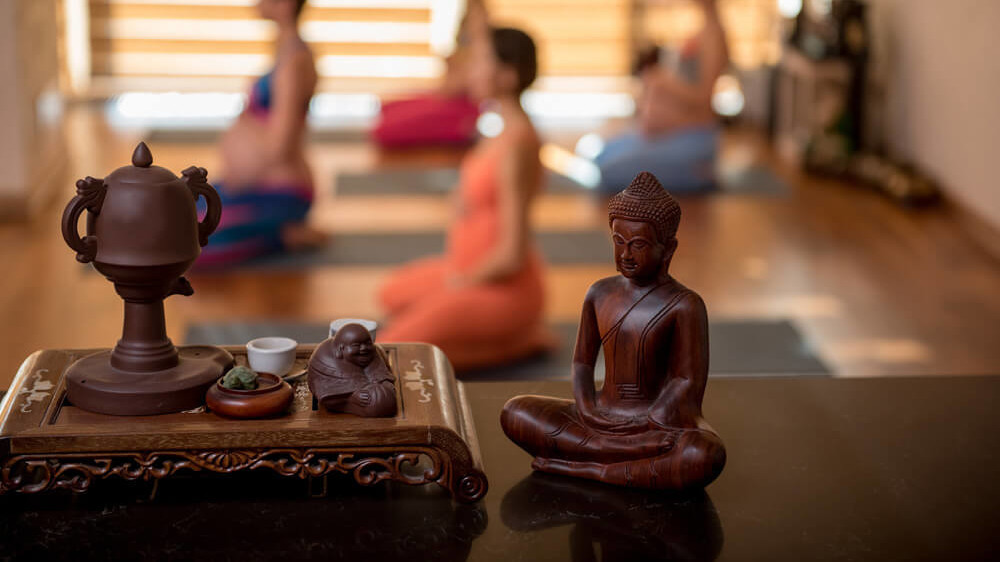Non-Religious Yoga Teacher Training
& Yoga Classes
The future of mainstream yoga is mind-body fitness.

PHOTO: Most modern yoga classes focus on mind-body fitness where the breath is synched up with deliberate movements to simultaneously train the body and calm the mind.
Are you interested in yoga without Hinduism or Buddhism mixed in? Do chakras, incense, and chanting to Shiva feel disingenuous to you? Do Om tattoos and Buddha statues in yoga studios seem disrespectful? You’re not alone.
Over 90% of yoga students prefer non-religious yoga, and yet most teachers offer a clumsy mix of mind-body fitness with pop spirituality. Why? The two main reasons are semantics and geography.
Semantics first. The term yoga was traditionally used to refer to one of six orthodox Hindu Philosophies from India. These six schools are Sankhya, Yoga, Nyaya, Vaisheshika, Mimamsa, and Vedanta. You probably haven’t heard of these and neither has your yoga teacher. That’s OK. Yoga philosophy is not for everyone and to be frank, it has absolutely nothing to do with your hip alignment in Warrior II or your breathing in Down Dog.
Geography is the next source of confusion. Yoga was born in India, home to all six of these schools of philosophy, and it’s a deeply religious and spiritual country to boot. When Westerners went to India nearly a century ago, not only did they learn the mind-body fitness practices of yoga but they also experienced lots of religion because they were surrounded by it.

PHOTO: Most studios and students are not Buddhist or Hindu, so why are disingenuous statues and symbols like this so common?
If an Indian had gone to Chicago about a hundred years ago to learn baseball, they would have thought that baseball was a Christian sport. They may have started doing the sign of the cross before stepping up to the plate, and they would have learned to pray before the big game. The Midwestern United States was deeply Christian back then, making sports and religion hard to parse out. Does that mean baseball is a spiritual practice? Possibly, but probably not for most people.
So are Sun Salutes a prayer to God? For some people, sure, but for the majority, they are simply an exceptional way to warm up for practice.
Most yoga teachers would never think of reciting the Lord’s Prayer at the end of class, but many will lead a Vedic or Pali chant. The same teacher that would never think of hanging a crucifix on the wall, will place a Buddha statue next to the soap dish in the bathroom. Why? The simple answer is ignorance. In India, it’s disrespectful to have an Om symbol below your heart, and you’d never ever step on it. But modern yoga students have them printed on their mats and they jump and sweat all over the symbol.

PHOTO: Most popular “yoga-approved” symbols and tattoos are rooted in Hindu or Buddhist faiths and lack cultural sensitivity.
Here’s why this matters today. Yoga students come in all shapes, sizes, and backgrounds. Some are Hindu, Christian, Jewish, or Muslim. Many are atheists, while others are spiritual but not religious; but all of them, every single one of them, is a person that has a right to their own beliefs and culture.
As a yoga teacher, studio owner, and teacher training, this is especially important to me because yoga is getting kicked out of public schools—and for good reason. Confused yoga teachers are ignorantly incorporating neo-Hindu and neo-Buddhist teachings into their classes in schools, and parents are mad. Religious parents are mad, but so are atheists. Who wants their kid getting religion from a yoga teacher with a random yoga certificate? Not me.
I’m a career teacher, and my dream is to see yoga teachings incorporated into every home, school, office, prison, and health care facility in the world. I’d love for more health insurance providers and employers to pay for yoga, but that won’t happen if teachers don’t begin educating themselves, respecting their students, and removing religious elements from classes.
Yoga philosophy is not mind-body fitness yoga. Yoga philosophy has been around for thousands of years and remains relatively unpopular and unknown. Yoga for mind-body fitness was born in the early 20th century in India, grew in the United States, and has now spread all over the world. Yoga philosophy and yoga for mind-body fitness are the same in name and place of origin, but they have nothing to do with one other.
To truly embrace diversity, respect other cultures, and people of all types, we need to create yoga communities that are based on mind-body fitness practices and leave religion and spirituality up to the individual.
No chanting, no chakras, no incense, no Oms… this is the official policy at my studios and training courses. Initially, yoga teachers mocked us, but our students embraced it instantly. Today, we’re proud to report that our studios boast a greater diversity of ethnicity and religion than any yoga community in the world because we create a space where people can be themselves.
The future of yoga philosophy is for religious studies and history majors at universities to write research papers on. The future of mainstream yoga is mind-body fitness.



